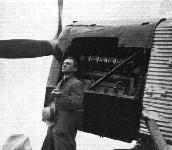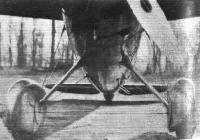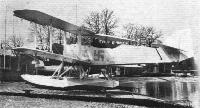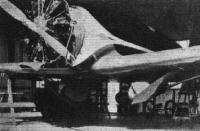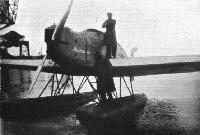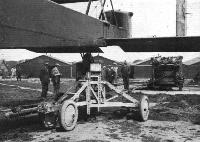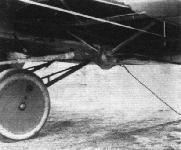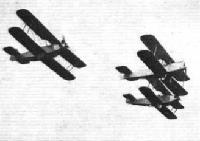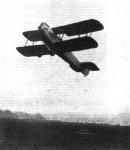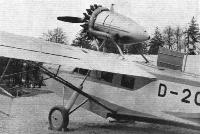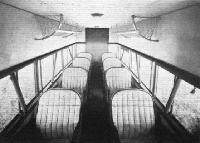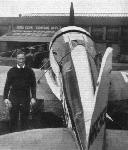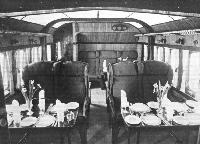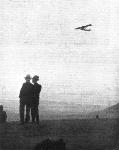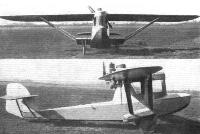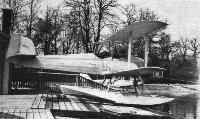Фотографии
-
Grp. Capt. R. C. M. Pink greeting General Gillieaux on his arrival with a squadron of the Belgian Army Air Corps at Manston.
Самолёты на фотографии: Breguet Br.19 - Франция - 1922
-
The Belgian Army Air Corps Squadron at Manston. The machines are Breguet XIX's reconnaissance aircraft and an built in Belgium. The Squadron arrived on May 5 and spent the rest of the week visiting other R.A.F. stations.
Самолёты на фотографии: Breguet Br.19 - Франция - 1922
-
Регистрационный номер: SE-ABW, S-AABW Самолёты на фотографии: Junkers K 47 / A 48 - Германия - 1928
-
EXPLAINING HOW IT WORKS: Dr. Gasterstedt, one of the designers, explaining to visitors to Tempelhofer Feld the principles upon which the Junkers heavy-oil engine is based.
Самолёты на фотографии: Junkers G 23 / G 24 - Германия - 1924
-
Регистрационный номер: SE-ABG THE SERIOUS SIDE: A three-engined Junkers seaplane belonging to the Swedish Air Transport Company.
Самолёты на фотографии: Junkers G 23 / G 24 - Германия - 1924
-
Регистрационный номер: D-1051 FOR THOROUGH TESTING IN THE AIR: The Junkers type F.24 into which the Junkers "Jumo 4" heavy-oil engine has been fitted.
Самолёты на фотографии: Junkers G 23 / G 24 - Германия - 1924
-
A ROYAL PRIVATE OWNER: The Prince of Wales is now well known as an enthusiastic owner of aircraft. Here he is alighting, together with Prince George, on his return to Windsor from their South American tour. On this occasion he made use of an Imperial Airways Argosy, although while at Buenos Aires he made extensive flights in his own Puss-Moth.
Самолёты на фотографии: Armstrong Whitworth Argosy - Великобритания - 1926
-
Excellent visibility is provided in the cockpit of the Westland Wessex, and the front windscreen now opens both in the front and at the side for use in bad weather. The latest model, with three 7-cylinder Genet engines, has a fine performance, and a recent flight in it with one engine stopped was a revelation.
Самолёты на фотографии: Westland Wessex / Westland IV - Великобритания - 1929
-
The new low drag undercarriage on the "Speed Vega."
Самолёты на фотографии: Lockheed Vega - США - 1927
-
A FINNISH MILITARY TWO-SEATER SEAPLANE: This machine is built by the Finnish Government Aircraft Works, and is fitted with a Bristol "Jupiter IV" engine.
Самолёты на фотографии: VL Kotka - Финляндия - 1930
-
View showing the undercarriage operation of the "Orion"
Самолёты на фотографии: Lockheed Orion 9 - США - 1931
-
Регистрационный номер: D-1422 DORNIER'S CONTRIBUTION: A "Wal" at one of the slipways in Lindarangsviken.
Самолёты на фотографии: Dornier Do.J Wal - Германия - 1922
-
MILITARY FRANCE: Three C.A.M.S. 55 flying boats at moorings in Lindarangsviken.
Самолёты на фотографии: CAMS CAMS 55 - Франция - 1928
-
CAPT. AHRENBERG: Our illustration shows Capt. J .Ahrenberg (on float) and his wireless operator, Ljunglund, just before setting out from Malmo for Greenland in the Junkers seaplane to take part in the rescue of Mr. Courtauld. Shell spirit and oil were used for this flight, which rendered material assistance in the rescue work.
Самолёты на фотографии: Junkers W 33 / W 34 / Ju.46 - Германия - 1926
-
THE PRINCE FLIES TO MANCHESTER: On May 9 the Prince flew in his "Puss Moth" from Hendon to Birmingham, and thence, on May 12, to Manchester. Our picture shows the Lord Mayor of Manchester (centre), presenting Aldermen to H.R.H. the Prince of Wales. On left is Lord Derby, who received the Prince on his arrival at Barton Airport.
Самолёты на фотографии: De Havilland Puss Moth / D.H.80 - Великобритания - 1929
-
Регистрационный номер: G-ABIJ A WELL-KNOWN PRIVATE OWNER: Sir Philip Sassoon's new Puss Moth (G-ABIJ).
Самолёты на фотографии: De Havilland Puss Moth / D.H.80 - Великобритания - 1929
-
View showing the undercarriage operation of the "Altaire"
Самолёты на фотографии: Lockheed Sirius / Altair 8 - США - 1929
-
Регистрационный номер: G-ABIM THE NEW SHELL-MEX AVIAN (GIPSY II): This aircraft has recently been added to the Shell fleet, as we announced in FLIGHT for February 20, and is fitted with Dunlop Semi-Balloon Aero Wheels. With the split axle undercarriage and the sports tyre fuselage top faring it should be an exceptionally pleasant machine.
Самолёты на фотографии: Avro Avian / Type 594/616 - Великобритания - 1926
-
Регистрационный номер: VH-UOC "MAN" HANDLING: A lady pupil of the Lasco Flying School, Melbourne, getting out a Bluebird (Genet Major).
Самолёты на фотографии: Blackburn Bluebird / L.1 - Великобритания - 1924
-
The "Virginia" and engines before the start.
Самолёты на фотографии: Vickers Virginia - Великобритания - 1922
-
The wheeled trolley on which the tail of the machine is supported in flying position.
Самолёты на фотографии: Vickers Virginia - Великобритания - 1922
-
This photograph shows the point at which the cable is attached by a hook to the fuselage.
Самолёты на фотографии: Vickers Virginia - Великобритания - 1922
-
Регистрационный номер: G-EBMW THE FIRST AIR MAIL TO AUSTRALIA: The ill-fated DH "Hercules" City of Cairo, of Imperial Airways, with the mail for Australia, refuelling at Batavia. The machine, it will be remembered, crashed at Kupang shortly after.
Самолёты на фотографии: De Havilland Hercules / D.H.66 - Великобритания - 1926
-
Регистрационный номер: G-AAJW, G-ABJW SIDE VIEW OF THE METAL "MARTLET": In spite of the fact that the machine is a vertical biplane, the view is very good.
Самолёты на фотографии: Southern Martlet - Великобритания - 1929
-
Самолёты на фотографии: Southern Martlet - Великобритания - 1929
-
AT SHOREHAM: On the left we show old and new Shoreham, in Mr. C. L. Pashley (right) - who was associated with this aerodrome in the very early days of flying and must now be not very far short of the 10,000-hours flying mark - and Mr. F. G. Miles, Managing Director of Southern Aircraft, a more recent "settler" at Shoreham. On the right we show the Mayor and Mayoress of Worthing standing beside the Metal "Martlet."
Самолёты на фотографии: Southern Martlet - Великобритания - 1929
-
The machine doing a "zoom."
Самолёты на фотографии: Southern Martlet - Великобритания - 1929
-
"FORMARTING": Three of the S.A.C. "Martlets" put up some excellent formation flying at Shoreham on Saturday last, as shown on the picture. The leading machine is the metal job, with Mr. Miles up, and on the left of the picture is the "Genet-Major" model, piloted by F/O. Leech, and on the right the "Genet II" model, piloted by F/O. Thorn.
Самолёты на фотографии: Southern Martlet - Великобритания - 1929
-
Регистрационный номер: F-AJMV ONE TYPE IN THE TOUR OF FRANCE: The Farman 190 (230 h.p. Titan), of which two were entered.
Самолёты на фотографии: Farman F.190 / F.390 - Франция - 1928
-
Регистрационный номер: F-AJPO FARMAN IN THE TOUR OF FRANCE: The type 230, a machine fitted with a 40 h.p. Salmson.
Самолёты на фотографии: Farman F.230 / F.350 - Франция - 1930
-
ONE TYPE IN THE TOUR OF FRANCE: The Schreck Amphibian 290 biplane flying boat (180 h.p. Hispano).
Самолёты на фотографии: FBA Type 290 - Франция - 1931
-
Регистрационный номер: D-2067 [3] THE ONLY AMPHIBIAN: Front view of the Heinkel H.E.57 six-seater.
Самолёты на фотографии: Heinkel HE.57 - Германия - 1929
-
Регистрационный номер: D-2067 [3] A CLOSE-UP OF THE HEINKEL: The engine is a Pratt & Whitney "Wasp." Note the hatch which gives access to the cabin.
Самолёты на фотографии: Heinkel HE.57 - Германия - 1929
-
Регистрационный номер: D-2067 [3] THE HEINKEL H.E.57: In this three-quarter front view may be noticed the combined tail skid and water rudder. The airscrew tips pass very close to the windscreen and probably cause considerable buffeting.
Самолёты на фотографии: Heinkel HE.57 - Германия - 1929
-
An interior view of the cabin of the Savoia-Marchetti "S 71."
Самолёты на фотографии: Savoia-Marchetti / SIAI S.71 / S.72 - Италия - 1930
-
Savoia-Marchetti "S-71" 3-240 h.p. Walter "Castor" Engines
Самолёты на фотографии: Savoia-Marchetti / SIAI S.71 / S.72 - Италия - 1930
-
Регистрационный номер: F-AJTY One of the twelve Potez 36 cabin monoplanes (95 h.p. Renault or Salmson) entered.
Самолёты на фотографии: Potez Potez 36 - Франция - 1929
-
Some of ths Potez 36 monoplanes lined up after arriving at Orly on May 10.
Самолёты на фотографии: Potez Potez 36 - Франция - 1929
-
Регистрационный номер: NR1313 [3] This side view of Capt. Hawks in the Travel Air "Texaco 13" shows how, by means of his adjustable seat, he is able to raise himself and, having pushed the top part of the windscreen forward, thus obtain a good view when approaching an aerodrome.
Самолёты на фотографии: Travel Air Type R Mystery Ship - США - 1929
-
Регистрационный номер: NR1313 [3] The Travel Air "Texaco 13" monoplane of Capt. Hawks created much interest at the Orly Meeting. Gen. Bares, Chief of Air Service (left), and Gen. Poli-Marchetti (right) are here seen discussing the machine.
Самолёты на фотографии: Travel Air Type R Mystery Ship - США - 1929
-
Регистрационный номер: NR1313 [3] Capt. Hawks at Brooklands. This photograph shows the rapid sweep-in of the fuselage in the region of the pilots cockpit. The very complete windscreen fairing over the cockpit is seen easily from this view
Самолёты на фотографии: Travel Air Type R Mystery Ship - США - 1929
-
COMFORT IN THE AIR: The cabin of the latest Short "Kents" sets a new high-water mark in comfort. The chairs are large and comfortable, and there is plenty of leg and elbow room, as well as head room. Noise has also been reduced very considerably, so that, altogether, passengers should be able to make the Mediterranean crossing without fatigue.
Looking forward in the cabin of a Kent, with tables laid for lunch.Самолёты на фотографии: Short Kent / S.17 - Великобритания - 1931
-
THE VICKERS SINGLE-ENGINED "VIASTRA": This machine has now been produced, according to the original plan, as a three-engined, twin-engined, and single-engined monoplane. West Australian Airways are using the twin-engined version on the Perth-Adelaide route. The single-engined type here shown landing at Brooklands is fitted with a Bristol "Jupiter" Series XI F.
Самолёты на фотографии: Vickers Viastra / Type 160 - Великобритания - 1930
-
Регистрационный номер: D-1731 ANOTHER HEINKEL AT STOCKHOLM: This twin float cabin seaplane is of more typical Heinkel appearance than the amphibian illustrated on previous pages.
Самолёты на фотографии: Heinkel HE.6 / HE.10 - Германия - 1926
-
READY TO START: Some of the Morane Saulnier Moths (85 h.p. Gipsy) line up for the start of the Tour of France at Orly.
Самолёты на фотографии: De Havilland Gipsy Moth / Moth X - Великобритания - 1928
-
Регистрационный номер: F-AJLQ The Morane Saulnier Moth (85 h.p. Gipsy), of which there were five.
Самолёты на фотографии: De Havilland Gipsy Moth / Moth X - Великобритания - 1928
-
A view down the gallery at the Agricultural Hall. The gliders from left to right are the Hols-der-Teufel, the Scud, the Albatross, and the B.A.C. VI. Between this last and the Albatross is one of the Rice folding caravans.
Самолёты на фотографии: Abbott-Baynes Scud - Великобритания - 1931Latimer-Needham Albatross - Великобритания - 1930Lippisch / RRG Hols der Teufel - Германия - 1923Lowe-Wylde Columbus / BAC.II - BAC.IX - Великобритания - 1930
-
Регистрационный номер: G-AASE THREE STAGES IN THE TAKE-OFF OF THE SUPERMARINE AIR YACHT: The the boat is on its step. Clean running characterises all three stages.
Самолёты на фотографии: Supermarine Air Yacht - Великобритания - 1930
-
The Dickson Glider of the Dannevirke Glider Club in New Zealand. Mr. L. Willicomb is at the controls.
Самолёты на фотографии: Lippisch / RRG Zogling - Германия - 1926
-
A London Gliding Club Prufling soaring over the Club's ground at Totternhoe near Dunstable. Such scenery as this is the common lot of the gliding enthusiast, as the sport takes him to the hills and not the flat uninteresting plains.
Самолёты на фотографии: Lippisch / RRG Prufling - Германия - 1926
-
THE FIZIR "A.F.2": These two views show most of the main features of the machine. The cabin top is detachable.
Самолёты на фотографии: Zmaj AF.2 / Fizir-Vega - Югославия - 1931
-
Регистрационный номер: CF-APS THE "CANADIAN CUB": A single-seater light 'plane designed and constructed in Canada, and fitted with a 40 h.p. A.B.C. "Scorpion II."
Самолёты на фотографии: Saynor & Bell Canadian Cub - Канада - 1930
-
HOME BUILT: Mr. E. A. Alton, of the Bombay Flying Club, by the aircraft which he has built for himself. The engine is an A.B.C. Scorpion, and on test the machine has proved exceptionally satisfactory.
Самолёты на фотографии: Alton (Edgar Alton) monoplane - Индия - 1931
-
Регистрационный номер: F-AIYL The winner of the Speed Contest of the Tour of France. The Guerchais type 12 (95 h.p. Renault) monoplane and its pilot Henry Massot.
Самолёты на фотографии: Guerchais T.12 - Франция - 1931
-
INTENDED FOR TRAINING: This Finnish seaplane, which has a Siemens engine of 120 h.p., has wooden floats of very excellent workmanship.
Самолёты на фотографии: VL Saaski - Финляндия - 1928
-
A POLISH AMPHIBIAN: The Pulawski "P.Z.L." amphibian flying boat, manufactured by Panstwowe Zaklady Lotnieze, in Poland. It is fitted with a D.H. "Gipsy III" engine, installed as a pusher. As such the engine has proved perfectly satisfactory, and the machine performs remarkably well.
Самолёты на фотографии: PZL PZL.12 - Польша - 1931
-
Регистрационный номер: SE-ABY [2] I.L.I.S.: The main exhibition building is seen on the right. On the left is the tent hangar occupied by the Finnish exhibits.
Самолёты на фотографии: De Havilland Moth Seaplane - Великобритания - 1926
-
Регистрационный номер: SE-ABY [2] NOT AN EXHIBIT: Another "Moth" seaplane whose home is at Lindarangen.
Самолёты на фотографии: De Havilland Moth Seaplane - Великобритания - 1926
-
Регистрационный номер: SE-ACN SWEDISH GIPSY MOTH SEAPLANE: In the background may be seen a small portion of the Free Harbour of Stockholm, which adjoins the seaplane station.
Самолёты на фотографии: De Havilland Moth Seaplane - Великобритания - 1926
Статьи
- Flight



